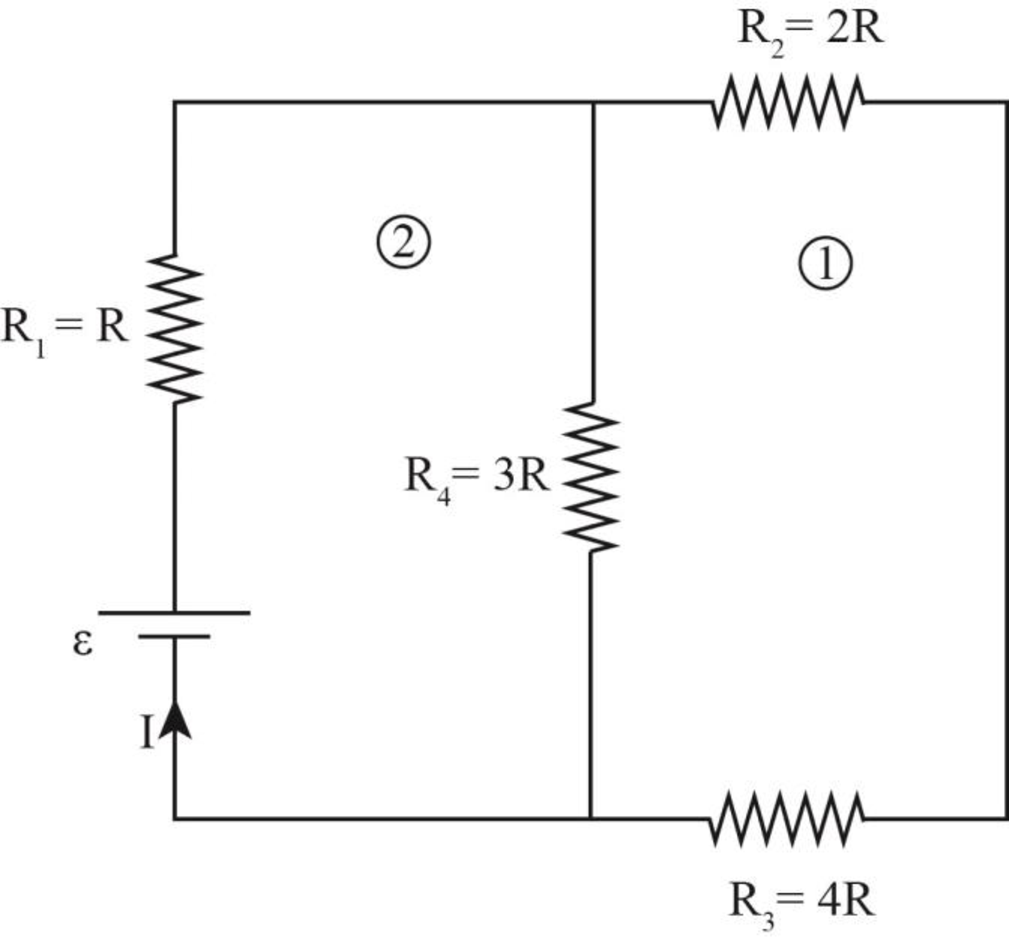
(a)
The potential difference across each resistor in terms of
(a)
Answer to Problem 16P
The potential difference across resistor
Explanation of Solution
Consider the circuit diagram as shown below.

Figure-(1)
Write the expression to calculate the resistance in loop 1.
Here,
Substitute
Write the expression to calculate the equivalent resistance in loop 1.
Here,
Substitute
Write the expression to calculate the equivalent current of the circuit.
Here,
Substitute
Write the expression to calculate the emf of the battery.
Here,
Substitute
Write the expression to calculate the potential drop across resistor
Here,
Substitute
Write the expression to calculate the potential drop across
Here,
Substitute
Since resistors
Write the expression to calculate the potential drop across resistor
Here,
Substitute
Write the expression to calculate the potential drop across resistor
Here,
Conclusion:
Substitute
Therefore, the potential difference across resistor
(b)
The current in each resistor in terms of
(b)
Answer to Problem 16P
The current through resistor
Explanation of Solution
Write the expression to calculate the current through resistor
Here,
Substitute
Write the expression to calculate the current through resistor
Here
Substitute
Write the expression to calculate the current through resistor
Here,
Substitute
Write the expression to calculate the current through resistor
Here,
Conclusion:
Substitute
Therefore, the current through resistor
(c)
The current in each of the resistors if
(c)
Answer to Problem 16P
Current through resistors
Explanation of Solution
If the resistance
As a result the current through resistor
(d)
The new values of the current in each resistor in terms of
(d)
Answer to Problem 16P
The current through resistors
Explanation of Solution
Write the expression to calculate the equivalent resistance.
Substitute
Write the expression to calculate the new current.
Here,
Substitute
Since, resistors
Write the expression to calculate the current across resistor
Conclusion:
Substitute the value in the above expression to calculate
Therefore, the current through resistors
Want to see more full solutions like this?
Chapter 28 Solutions
Physics For Scientists And Engineers With Modern Physics, 9th Edition, The Ohio State University
- (a) For a spherical capacitor with inner radius a and outer radius b, we have the following for the capacitance. ab C = k₂(b- a) 0.0695 m 0.145 m (8.99 × 10º N · m²/c²)( [0.145 m- 0.0695 m × 10-11 F = PF IIarrow_forwardA pendulum bob A (0.5 kg) is given an initialspeed of vA = 4 m/s when the chord ishorizontal. It then hits a stationary block B (1kg) which then slides to a maximum distanced before it stops. Determine the value of d.The coefficient of static friction between theblock and the plane is μk = 0.2. The coefficientof restitution between A and B is e = 0.8.Ans: d=1.0034 marrow_forwardFigure 29-43 Problem 12. ••13 In Fig. 29-44, point P₁ is at distance R = 13.1 cm on the perpendicular bisector of a straight wire of length L = 18.0 cm carrying current i = 58.2 mA. (Note that the wire is not long.) What is the magnitude of the magnetic field at P₁ due to i? P2° R R Larrow_forward
- Checkpoint 1 The figure shows the current i in a single-loop circuit with a battery B and a resistance R (and wires of neg- ligible resistance). (a) Should the emf arrow at B be drawn pointing leftward or rightward? At points a, B C R b, and c, rank (b) the magnitude of the current, (c) the electric potential, and (d) the electric potential energy of the charge carriers, greatest first.arrow_forwardPls help ASAParrow_forwardPls help asaparrow_forward
 Physics for Scientists and EngineersPhysicsISBN:9781337553278Author:Raymond A. Serway, John W. JewettPublisher:Cengage Learning
Physics for Scientists and EngineersPhysicsISBN:9781337553278Author:Raymond A. Serway, John W. JewettPublisher:Cengage Learning Physics for Scientists and Engineers with Modern ...PhysicsISBN:9781337553292Author:Raymond A. Serway, John W. JewettPublisher:Cengage Learning
Physics for Scientists and Engineers with Modern ...PhysicsISBN:9781337553292Author:Raymond A. Serway, John W. JewettPublisher:Cengage Learning Physics for Scientists and Engineers, Technology ...PhysicsISBN:9781305116399Author:Raymond A. Serway, John W. JewettPublisher:Cengage Learning
Physics for Scientists and Engineers, Technology ...PhysicsISBN:9781305116399Author:Raymond A. Serway, John W. JewettPublisher:Cengage Learning
 Principles of Physics: A Calculus-Based TextPhysicsISBN:9781133104261Author:Raymond A. Serway, John W. JewettPublisher:Cengage Learning
Principles of Physics: A Calculus-Based TextPhysicsISBN:9781133104261Author:Raymond A. Serway, John W. JewettPublisher:Cengage Learning Physics for Scientists and Engineers: Foundations...PhysicsISBN:9781133939146Author:Katz, Debora M.Publisher:Cengage Learning
Physics for Scientists and Engineers: Foundations...PhysicsISBN:9781133939146Author:Katz, Debora M.Publisher:Cengage Learning





